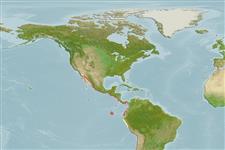>
Eupercaria/misc (Various families in series Eupercaria) >
Gerreidae (Mojarras)
Etymology: Diapterus: Greek, di = two + Greek, pteron = wing, fin (Ref. 45335).
More on author: Cuvier.
Environment: milieu / climate zone / depth range / distribution range
Écologie
marin démersal; profondeur 1 - 30 m. Tropical; 32°N - 13°S, 114°W - 75°W
Eastern Pacific: Mazatlan, Mexico to Callao, Peru.
Taille / Poids / Âge
Maturity: Lm ? range ? - ? cm
Max length : 35.0 cm TL mâle / non sexé; (Ref. 124487); common length : 15.0 cm TL mâle / non sexé; (Ref. 55763); poids max. publié: 471.98 g (Ref. 124487)
Body diamond-shaped, compressed, and deep (depth contained 1.9 to 2.0 times in standard length); predorsal profile very compressed; mouth strongly protractile; preopercular border serrate; dorsal fin not notched to its base; second anal spine long and stout; body silver or gold with blue iridescent highlights; pelvic and anal fins yellow with dark rays (Ref. 55763).
Common in coastal waters. Juveniles inhabit lagoons of mangrove areas and tidal streams; adults are found over soft bottoms of deeper waters. May enter brackish waters (Ref. 37955). Feeds on benthic invertebrates and fishes. Its flesh is considered of good quality (Ref. 9303). Depth range assumed (RF).
Life cycle and mating behavior
Maturité | Reproduction | Frai | Œufs | Fécondité | Larves
González-Acosta, A.F., P. Béarez, N. Álvarez-Pliego, J. De La Cruz-Agüero and J.L. Castro-Aguirre, 2007. On the taxonomic status of Diapterus peruvianus (Cuvier, 1830) and reinstatement of Diapterus brevirostris (Sauvage, 1879) (Teleostei: Gerreidae). Cybium 31(3):369-377. (Ref. 75986)
Statut dans la liste rouge de l'IUCN (Ref. 130435)
Menace pour l'homme
Harmless
Utilisations par l'homme
Pêcheries: commercial
Plus d'informations
Noms communsSynonymesMétabolismePrédateursÉcotoxicologieReproductionMaturitéFraiRassemblement de ponteFéconditéŒufsDéveloppement de l'œuf
RéférencesAquacultureProfil d'aquacultureSouchesGénétiqueElectrophoresesHéritabilitéPathologiesTraitementNutrientsMass conversion
CollaborateursImagesStamps, Coins Misc.SonsCiguateraVitesseType de nageSurface branchialeOtolithesCerveauxVision
Outils
Articles particuliers
Télécharger en XML
Sources Internet
Estimates based on models
Preferred temperature (Ref.
123201): 21 - 28.5, mean 25.9 °C (based on 54 cells).
Phylogenetic diversity index (Ref.
82804): PD
50 = 0.5625 [Uniqueness, from 0.5 = low to 2.0 = high].
Bayesian length-weight: a=0.01318 (0.01065 - 0.01632), b=3.05 (2.99 - 3.11), in cm total length, based on LWR estimates for this species (Ref.
93245).
Niveau trophique (Ref.
69278): 3.7 ±0.2 se; based on diet studies.
Résilience (Ref.
120179): Haut, temps minimum de doublement de population inférieur à 15 mois (Preliminary K or Fecundity.).
Fishing Vulnerability (Ref.
59153): Low vulnerability (25 of 100).
Nutrients (Ref.
124155): Calcium = 173 [85, 331] mg/100g; Iron = 1.06 [0.53, 2.08] mg/100g; Protein = 18.3 [16.3, 20.2] %; Omega3 = 0.179 [0.091, 0.344] g/100g; Selenium = 46.2 [23.1, 98.7] μg/100g; VitaminA = 14 [3, 46] μg/100g; Zinc = 1.02 [0.66, 1.58] mg/100g (wet weight);
